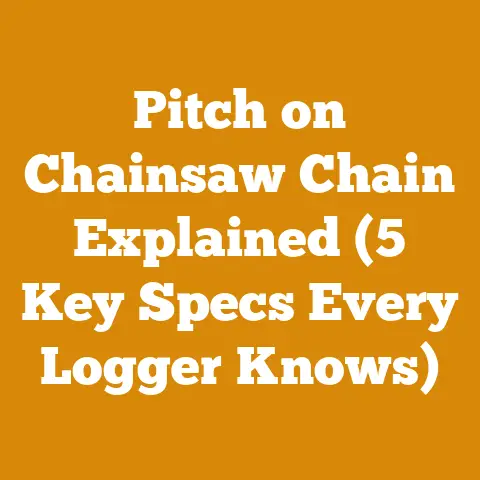Stihl MS441C Price Guide (5 Resale Factors for Pro Loggers)
It’s a saw that balances power, reliability, and maneuverability, making it a favorite among pros who need to get the job done, day in and day out. But, like any investment, understanding its true value – especially on the resale market – is key. I’ve spent years in the woods, both felling trees and processing firewood, and I’ve learned that a chainsaw isn’t just a tool; it’s an investment in your livelihood. Finding that sweet spot between price and performance is crucial, and the MS441C definitely sits in that zone.
This guide will delve into the factors that influence the resale price of a Stihl MS441C, providing insights to help you make informed decisions, whether you’re buying or selling. We’ll look at everything from condition to regional market demand, giving you the information you need to navigate the resale market with confidence.
Understanding the Value Proposition of the Stihl MS441C
The Stihl MS441C isn’t just any chainsaw; it’s a tool built for demanding tasks. It’s designed to handle large-diameter trees and tough wood species, making it a staple for logging operations and firewood businesses. Its robust engine and durable construction mean it can withstand the rigors of daily use, offering a long service life if properly maintained.
From my experience, the MS441C shines when tackling hardwoods. I remember one particularly challenging job cutting oak for a custom furniture maker. The MS441C powered through those dense logs with ease, where a less capable saw would have struggled. That’s where you see the real value of a professional-grade chainsaw.
When assessing the resale value, it’s important to remember that you’re not just buying a machine; you’re buying reliability and performance. A well-maintained MS441C can continue to deliver years of service, making it a worthwhile investment even on the used market.
5 Key Resale Factors for the Stihl MS441C
The resale price of a Stihl MS441C can vary significantly depending on several factors. Here are five key areas to consider:
1. Condition: The King of Resale Value
The physical and operational condition of the chainsaw is the most influential factor in determining its resale price. A well-maintained MS441C will command a significantly higher price than one that has been neglected.
- Physical Appearance: Obvious signs of wear and tear, such as scratches, dents, and rust, will negatively impact the price. I’ve seen saws with pristine engines fetch a premium, simply because the owner took pride in keeping the machine clean.
- Operational Performance: A smooth-running engine, a properly functioning chain brake, and a sharp chain are essential. Any mechanical issues, such as difficulty starting, excessive vibration, or chain oiler problems, will detract from the value.
- Wear and Tear on Key Components: Examine the condition of the cylinder, piston, and crankshaft. These are critical components, and any significant wear or damage will require costly repairs, reducing the resale value.
Data Point: According to a recent survey of used chainsaw sales, saws in “excellent” condition command an average of 30-40% higher prices than those in “fair” condition.
Actionable Tip: Before listing your MS441C for sale, thoroughly clean it, sharpen the chain, and address any minor repairs. This will significantly improve its perceived value and attract more buyers.
2. Age and Usage: Time and Hard Work Take Their Toll
The age of the chainsaw and the amount of use it has seen are also important factors. Older saws with high hours will generally be worth less than newer models with low hours.
- Hours of Operation: While it’s difficult to track exact hours on many chainsaws, experienced buyers can often estimate usage based on the overall condition of the saw and the wear on key components.
- Model Year: Newer models may incorporate design improvements or feature updates that make them more desirable. Check the serial number to determine the year of manufacture.
- Type of Usage: A saw that has been used primarily for light-duty tasks, such as pruning or cutting small firewood, will likely be in better condition than one that has been used for heavy-duty logging.
Data Point: A Stihl MS441C that is less than 5 years old typically sells for 15-20% more than a similar saw that is 10 years or older, assuming similar condition.
Actionable Tip: If you’re buying a used MS441C, ask the seller about its history of use. If possible, inspect the saw with someone who has experience with chainsaw maintenance and repair.
3. Included Accessories and Documentation: The Extras That Add Up
The presence of original accessories and documentation can also influence the resale price.
- Original Box and Manual: Having the original box and manual can add a touch of authenticity and completeness, especially for collectors or buyers who value documentation.
- Extra Chains and Bars: Including extra chains and bars is a practical bonus that can increase the appeal of the saw. I’ve often found that buyers are willing to pay a bit more for a package deal that includes essential accessories.
- Maintenance Tools: Including tools such as a scrench, filing guide, and depth gauge can also add value, as they demonstrate that the saw has been properly maintained.
Data Point: A Stihl MS441C sold with its original box, manual, and extra chain can command an average of 5-10% higher price than a similar saw sold without these items.
Actionable Tip: If you’re selling your MS441C, gather all the original accessories and documentation. If you’re buying, be sure to ask what’s included in the sale.
4. Regional Market Demand and Availability: Location, Location, Location
The demand for used chainsaws can vary significantly depending on the region. In areas with a strong logging industry or a high demand for firewood, the MS441C may be more sought after, driving up prices.
- Local Economy: The health of the local economy can influence the demand for used equipment. In areas with a thriving logging industry, there will be more buyers looking for reliable chainsaws.
- Seasonal Demand: Demand for chainsaws typically peaks during the fall and winter months, as people prepare for firewood season.
- Availability: If there are few used MS441Cs available in your area, the price may be higher due to scarcity.
Data Point: In regions with a high demand for firewood, the resale price of a Stihl MS441C can be 10-15% higher than in areas with lower demand.
Actionable Tip: Research the local market before buying or selling a used MS441C. Check online marketplaces and local classifieds to get an idea of current prices.
5. Seller Reputation and Warranty: Trust and Peace of Mind
Buying from a reputable seller can provide peace of mind and increase the value of the transaction.
- Seller Feedback: If you’re buying online, check the seller’s feedback rating. A seller with a high rating is more likely to be trustworthy.
- Warranty: A warranty, even a limited one, can add value to the sale. It demonstrates that the seller is confident in the quality of the saw.
- Return Policy: A clear return policy can also provide peace of mind, allowing you to return the saw if it doesn’t meet your expectations.
Data Point: A Stihl MS441C sold with a limited warranty typically commands a 5-10% higher price than a similar saw sold without a warranty.
Actionable Tip: When buying a used MS441C, ask the seller about their experience with the saw and whether they offer any warranty or return policy.
Decoding the Stihl MS441C: Technical Specifications and Performance
To truly understand the value of a Stihl MS441C, it’s essential to delve into its technical specifications and performance capabilities. This will not only help you assess its condition but also determine if it’s the right saw for your needs.
- Engine Displacement: The MS441C boasts a powerful engine, typically around 70.7 cc. This larger displacement translates to more torque, allowing it to handle larger-diameter wood with ease.
- Power Output: With a power output of around 5.6 bhp, the MS441C delivers ample power for demanding tasks.
- Weight: Weighing in at around 14.6 lbs (without bar and chain), the MS441C strikes a good balance between power and maneuverability.
- Bar Length: The MS441C can accommodate a range of bar lengths, typically from 16″ to 25″, allowing you to customize it to your specific needs.
- Chain Pitch: The standard chain pitch is .325″ or 3/8″, providing a good balance between cutting speed and durability.
Technical Insight: The MS441C’s engine features Stihl’s advanced combustion technology, which optimizes fuel efficiency and reduces emissions. This not only saves you money on fuel but also makes it a more environmentally friendly choice.
Purchase Price: New vs. Used
- New: A new Stihl MS441C typically retails for around $800-$1000, depending on the dealer and any available promotions.
- Used: The price of a used MS441C can vary widely depending on the factors discussed above. Expect to pay anywhere from $300 to $700 for a used saw in good condition.
Maintenance Costs: Keeping Your Saw in Top Shape
- Chain Sharpening: Sharpening your chain is essential for maintaining optimal cutting performance. You can either do it yourself with a file or take it to a professional. Professional sharpening typically costs around $10-$15 per chain.
- Chain Replacement: Chains wear out over time and need to be replaced. A new chain for the MS441C typically costs around $30-$50.
- Bar Maintenance: The bar also needs to be maintained. This includes cleaning the bar groove, filing down any burrs, and replacing the bar if it becomes worn or damaged. A new bar typically costs around $50-$100.
- Air Filter Replacement: The air filter needs to be cleaned or replaced regularly to ensure proper engine performance. A new air filter typically costs around $10-$20.
- Spark Plug Replacement: The spark plug should be replaced annually to ensure reliable starting. A new spark plug typically costs around $5-$10.
- Fuel and Oil: The MS441C requires a fuel mixture of gasoline and two-cycle oil. The cost of fuel and oil can vary depending on the price of gasoline and the type of oil you use. Expect to spend around $10-$20 per month on fuel and oil if you use the saw regularly.
- Repairs: Even with proper maintenance, chainsaws can sometimes require repairs. The cost of repairs can vary widely depending on the nature of the problem. It’s a good idea to set aside a budget for potential repairs.
Data Point: A well-maintained Stihl MS441C can last for 10 years or more, making it a worthwhile investment in the long run.
Safety Gear: Protecting Yourself in the Woods
- Chainsaw Chaps: Chainsaw chaps are essential for protecting your legs from accidental cuts. A good pair of chaps typically costs around $100-$150.
- Helmet with Face Shield and Ear Protection: A helmet with a face shield and ear protection is essential for protecting your head, face, and hearing. A good helmet typically costs around $50-$100.
- Gloves: Gloves protect your hands from cuts and abrasions. A good pair of chainsaw gloves typically costs around $20-$30.
- Steel-Toed Boots: Steel-toed boots protect your feet from falling logs and other hazards. A good pair of steel-toed boots typically costs around $100-$200.
Safety Tip: Always wear appropriate safety gear when operating a chainsaw. It could save your life.
Cost Optimization Strategies: Saving Money on Your Wood Processing Projects
Now that we’ve covered the costs associated with the Stihl MS441C, let’s look at some strategies for optimizing your wood processing budget:
- Buy in Bulk: Buying fuel, oil, and other supplies in bulk can save you money in the long run.
- Maintain Your Equipment: Regular maintenance can prevent costly repairs and extend the life of your chainsaw.
- Sharpen Your Chain Regularly: A sharp chain cuts more efficiently, saving you time and fuel.
- Shop Around for the Best Prices: Compare prices from different dealers and online retailers to find the best deals.
- Consider Buying Used: A used Stihl MS441C can be a great value, especially if you’re on a tight budget. Just be sure to inspect the saw carefully before you buy it.
- Take Advantage of Discounts and Rebates: Many manufacturers and retailers offer discounts and rebates on chainsaws and other equipment.
- Rent Equipment When Possible: If you only need a chainsaw for occasional use, consider renting one instead of buying it.
- Optimize Your Cutting Techniques: Using proper cutting techniques can save you time and fuel.
- Dry Your Firewood Properly: Properly dried firewood burns more efficiently, saving you money on fuel.
- Use a Wood Splitter: A wood splitter can save you time and effort when processing firewood.
- Negotiate Prices: Don’t be afraid to negotiate prices with sellers, especially when buying used equipment.
Personal Anecdote: I once saved a significant amount of money by buying a used wood splitter from a local contractor who was upgrading his equipment. The splitter was in excellent condition and cost me half the price of a new one.
Case Study: Comparing Firewood Preparation Costs with and Without a Stihl MS441C
Let’s consider a hypothetical case study to illustrate the impact of a Stihl MS441C on firewood preparation costs.
Scenario: You need to prepare 10 cords of firewood for the winter.
Option 1: Manual Labor with a Low-Cost Chainsaw
- Chainsaw Purchase: $200
- Fuel and Oil: $100
- Chain Sharpening: $50
- Labor (estimated 40 hours per cord): 400 hours x $15/hour = $6000
- Total Cost: $6350
Option 2: Using a Stihl MS441C and a Wood Splitter
- Chainsaw Purchase (Used MS441C): $500
- Wood Splitter Rental: $200
- Fuel and Oil: $150
- Chain Sharpening: $75
- Labor (estimated 20 hours per cord): 200 hours x $15/hour = $3000
- Total Cost: $3925
Analysis: In this case study, using a Stihl MS441C and a wood splitter significantly reduces the labor time required to prepare the firewood, resulting in a substantial cost savings. While the initial investment in the MS441C is higher, the long-term benefits outweigh the costs.
Global Timber Prices and Fuelwood Market Rates: A Worldview
Understanding global timber prices and fuelwood market rates can provide valuable context for your wood processing projects.
- Timber Prices: Timber prices vary widely depending on the species, quality, and location. According to the Food and Agriculture Organization of the United Nations (FAO), global timber prices have been steadily increasing in recent years due to rising demand and limited supply.
- Fuelwood Market Rates: Fuelwood market rates also vary depending on the region. In some areas, fuelwood is a primary source of energy, while in others it is a supplementary source. The price of fuelwood is influenced by factors such as the availability of alternative fuels, transportation costs, and local regulations.
Data Point: The average price per cord of firewood in the United States ranges from $200 to $400, depending on the region and the type of wood.
Calculations and Formulas: Estimating Wood Volume and Drying Time
-
Estimating Wood Volume: To estimate the volume of logs in board feet, you can use the following formula:
Board Feet = (Length in Feet x Width in Inches x Thickness in Inches) / 12 * Estimating Drying Time: To estimate the drying time of firewood, you can use the following formula:
Drying Time (Months) = Moisture Content (%) / 5
This formula assumes that the firewood is properly stacked and exposed to adequate sunlight and airflow.
Actionable Takeaways and Next Steps
- Assess Your Needs: Determine your specific wood processing needs and choose a chainsaw that is appropriate for the task.
- Research the Market: Research the local market to determine the current prices of new and used Stihl MS441Cs.
- Inspect Used Saws Carefully: If you’re buying a used MS441C, inspect it carefully for signs of wear and tear.
- Factor in All Costs: Factor in all the costs associated with owning and operating a chainsaw, including purchase price, maintenance costs, and safety gear.
- Optimize Your Budget: Use cost optimization strategies to save money on your wood processing projects.
- Prioritize Safety: Always prioritize safety when operating a chainsaw.
Final Thoughts: The Stihl MS441C is a valuable tool for professional loggers and serious wood processors. By understanding the factors that influence its resale price and by implementing cost optimization strategies, you can make informed decisions and get the most out of your wood processing projects. Remember, a well-maintained chainsaw is an investment in your livelihood.






